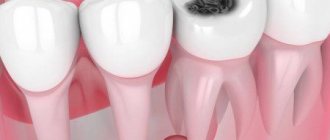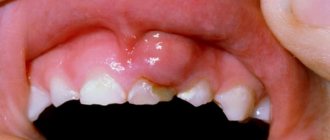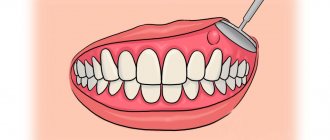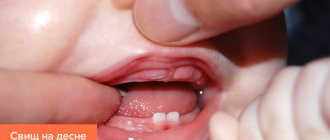How can a fistula on the gum be cured?
Of course, we treat it, we deal with it, we work for it. In order to cure a fistula on the gum, first of all, we should eliminate the reason due to which the fistula occurred. We should not
fight the pimple itself, smear it with various ointments and lotions, but must eliminate the cause of its occurrence.
We must
eliminate the chronic inflammation itself that led to this fistula.
The first treatment option for a fistula is endodontic
For such treatment, we provide the patient with high-quality endodontic treatment under a microscope when:
- the tooth canal itself is visible,
- its branches are visible
- and you can see if there are cracks in the tooth canal.
Our doctors perform minimally invasive treatment procedures under a microscope at a high level. Treatment of processes that led to a fistula, to a fistulous tract on the gum, to complications of various periodontitis. In the video - endodontist of the Scientific Research Center, winner of many international competitions in endodontics and dental restoration Melikov Azer:
In the clinics of the German Implantology Center, special materials are used that seal the apical part very well and for a long period, which are biocompatible with the tissues surrounding the tooth and which give a very good result.
That is, we have a therapeutic method of treatment - this time
. When highly qualified endodontists, using microscopes, special equipment and special materials, carry out canal therapy and eliminate the cause of the fistula.
The second treatment option for fistula is mixed
Second method
- This is a mixed treatment, when treatment is carried out jointly by a therapist and a surgeon. If the lesion is already quite strong, lysis of a certain part of the root apex has occurred, when the process has already been going on for quite a long time, then the therapist cleans the canals:
seals the apical part of the root with a special material, and the surgeon opens, makes surgical access and polishes the apical part of the tooth root.
We do not perform dental resections when the tooth is cut down in half. You often think, I often have patients come to me who have had a resection and you think the person has had ⅔ of the root cut off and this tooth is no longer tenable, it can barely hold on, and why did it have to be done? We do it minimally invasively. We polish the apical part of the root with special ultrasonic tips after the therapist has carried out the treatment, and we get very good long-term results.
The third treatment option is surgery.
There is also a surgical method - this is the third method
treatment when the inflammation is already chronic according to the principle “No tooth - no caries, no periodontitis, no nothing.”
That is, the tooth is removed
, the source of inflammation is removed:
and an implant is placed
:
Subsequent rehabilitation of the patient takes place on the implant.
The fourth treatment option is autotransplantation.
Autotransplantation is a type of third, surgical treatment option. But the patient’s own donor tooth acts as an implant. As a rule, wisdom teeth, which are not involved in the process of chewing food and are actually the body’s reserve for such cases, are excellent for this role. Wisdom teeth transplantation is suitable for posterior teeth and premolars (fourth, fifth, sixth and seventh teeth).
Advantage
This method of treatment is that the patient’s own tooth is transplanted, the patient’s own tissue, which is not foreign to the body, even in conditions of the inflammatory process with a fistula, significantly reduces the risk of tooth-implant rejection.
The specialists of the German Implantology Center have accumulated many years of clinical experience in such operations. You can see how the autotransplantation operation takes place in the following video. There, at the end of the film, the patient shares his impressions of the dental transplant (this is a review 1 year after
the transplant operation):
Why gums fester: reasons
1) With an exacerbation of chronic periodontitis , infection in the root canals leads to the formation of a focus of purulent inflammation at the apex of the tooth root. Depending on the type and size of such lesions, dentists call them by terms: granuloma, cyst or granulating periodontitis. You may not be aware of the presence of such foci for years, but sooner or later an exacerbation of chronic inflammation occurs, and then pus-filled abscesses form in the projection of these foci on the gums (Fig. 1-2).
2) Against the background of inflammation of the gums (with periodontitis) - in slightly less than half of all cases when the patient's gums near the tooth fester - the cause is a local or generalized form of periodontitis. Despite the fact that the causes of these two forms of periodontitis are different, the common thing is that the formation of a purulent abscess occurs in a deep periodontal pocket formed between the gum and the surface of the tooth root. Below you can see what an abscess on the gum looks like during periodontitis (Fig. 3).
The causes and treatment of an abscess on the gum will always be interconnected, and therefore, depending on the background of what disease (periodontitis or periodontitis) the suppuration occurred, either treatment of the root canals and the source of inflammation at the apex of the tooth root will be indicated, or treatment of the periodontal pocket using anti-inflammatory therapy , curettage and other methods. Below we will discuss in detail the treatment of gum suppuration in both cases.
Features of treatment of fistula with concomitant diseases
Are there any particularities in the treatment of fistula if the process is accompanied by other diseases in the oral cavity, such as periodontitis? No, in fact there is no particular connection. Periodontitis is an inflammation of the periodontium of a tooth, while periodontitis is an inflammation of the apical tissues surrounding the tooth. Of course, in some very severe forms, periodontitis can lead to the formation of fistulas, but often these are all unrelated, and one should be treated separately. First, cure periodontitis, if the tooth is healthy, if it does not wobble and can be preserved, and then treat periodontitis.
How long does it take for a patient to recover after fistula treatment?
The treatment of chronic periodontitis itself is not quick, since the patient must first open the tooth canal, clean it, disinfect it with special antimicrobial drugs, and only after that the tooth canal is sealed. If we talk about rehabilitation, when the results are visible, the fistula “goes away” almost immediately, and the bone takes a long time to recover.
If we talk about the surgical method
treatment of periodontitis, when the apical part of the tooth is opened according to the type of resection, but the apical part of the root is polished, the mucous membrane is restored quite quickly - this is
3-5 days
.
What happens in the mouth after tooth extraction?
A wound formed in the mouth creates problems:
- it can bleed for quite a long time;
- food can get into it and cause repeated injury;
- it can fester, infecting surrounding tissues.
How long does it take for gums to heal after tooth extraction under normal conditions? After the surgeon removes the tooth, the healing process begins, and the ligament surrounding the removed tooth begins to contract. A blood clot forms in the wound itself, which will protect it from infection. After a couple of days, granulation tissue begins to form, which over time is replaced by osteoid tissue. As a result, after 2–2.5 weeks the edges of the wound come closer together, and then young bone is formed, over which the gums take shape.
Recommendations after fistula treatment
After treatment of the fistula, no special recommendations need to be followed. If the treatment was related to surgery and was carried out jointly with a therapist, then yes:
- baths with antimicrobial agents must be done carefully,
- eat soft food
- Do not put your tongue into the area of the healing wound.
If we are simply talking about therapeutic treatment, then there are no special restrictions at all.
How to avoid the appearance of a fistula on the gum
Are there any prevention methods to avoid the development of periodontitis? Of course, you can avoid the appearance of a fistula on the gums, and the prevention of these fistulas is a regular visit to the dentist in order to avoid these fistulas, not to lead to chronic periodontitis, and to keep your teeth healthy, beautiful and functional.
Therefore, once every six months
You need to come to the dentist for an examination and early diagnosis of any diseases, diagnosis of caries. It is better to cure caries at an early stage than to treat canals later, or to re-treat canals that can lead to the formation of a sinus tract and a fistula on the gum.
Can a fistula on the gum go away on its own?
Yes, it can only go away on its own if the causative tooth is removed, then it will go away on its own. It's a joke! In fact, the fistula cannot go away on its own as long as there is a chronic process that occurs in the gums, in the hard tissues of the upper or lower jaw. This chronic process is ongoing, and through this fistula there is an outflow, all purulent masses are drained along with exudate. And all this goes into the body, the body is certainly poisoned. There is a constant infection - these are staphylococci, which can then provoke all sorts of sore throats and various other diseases in the oral cavity. This is unhealthy flora that is constantly in your mouth, which constantly oozes, flows out and poisons you from the inside.
The fistula itself cannot go away
. It must be treated either therapeutically or surgically.
Symptoms of gum injuries
Patients usually notice acute injuries immediately, while signs of chronic injuries may appear gradually. At the first stage, symptoms of inflammation appear, the mucous membrane turns red and swells. Painful sensations appear when pressing on the injured area. If the damage is mechanical, the injured area on the mucosa is usually clearly visible. With regular chemical or thermal burns, an eroded area appears on it, which becomes covered with a gray coating and bleeds easily.
Without treatment, the gum condition may worsen:
- an ulcer with a dark surface appears on the injured area;
- serous or purulent discharge appears;
- a wound may form with swelling around it. Its edges are usually roughened, and it bleeds easily;
- severe pain in the affected area appears.
What happens if the fistula is not treated?
If the fistula is not treated, then nothing good will end. The tooth will need to be removed, and what’s more, the bone surrounding the tooth suffers greatly, and the vestibular cortical plate suffers. When the tooth is not treated, when the cause of the fistula is not dealt with, the cortical plate is quite destroyed. Large cavities are formed in the bone, as exudate is formed, all this rots and the bone decomposes, softens and becomes infected, lyses, and exits through the fistulous tract.
Therefore, in addition to, as I said earlier, there is a fairly strong load on the body, since a fistula is a constant open source of infection in the oral cavity.
What problems may arise after tooth extraction?
Many patients experience swelling and pain in the gums during the first time after tooth extraction, but in most cases these problems quickly disappear. If the removal was traumatic, recovery may take longer. What factors influence the rate of wound healing?
- Her condition immediately after the operation, determined by the qualifications of the surgeon.
- The addition of a secondary infection, in most cases provoked by the patient himself.
- The patient has diseases that affect blood clotting and prevent the formation of a blood clot.
Therefore, it is so important to seek qualified dental care - in a reputable clinic, with an experienced surgeon who does not make annoying, unforgivable mistakes during surgery.
Treatment of children at RAIDEN
In the RAIDEN network of dental clinics, the treatment and prevention of oral diseases of young patients is treated with the utmost attention and reverence - the health of the younger generation is very important to us!
All medications used in our clinic meet the highest quality requirements. Before using them, we conduct a blood test of the baby to determine drug tolerance. The safety of your children, our little patients, is paramount to us.
Prevention of gum disease in children
Experts are confident that you can completely avoid gum disease if you follow 5 rules:
- Teach your child to chew food correctly with all chewing teeth.
- Show your child the correct technique for brushing teeth and additional flossing.
- Eliminate malocclusions in a timely manner and select orthodontic appliances.
- Do not give your child too cold or hot food (temperature no more than 30o C).
- Use a fingertip to stimulate the gums as baby teeth emerge.
Prevention
The development of the disease can be prevented with the help of general strengthening measures: it is important to adhere to a daily routine, provide nutrition taking into account the body’s needs for vitamins and minerals, and pay attention to the prevention of infectious diseases.
The development of stomatitis can be avoided using simple measures, such as:
- regular oral hygiene, which should begin from the moment the baby’s first tooth appears;
- use of toothpastes without sodium lauryl sulfate. This component increases the risk of developing the disease;
- routine examinations by a pediatric dentist;
- rinsing the mouth after every meal;
- limited consumption of sweets.
Pediatric dentists at STOMA clinics are ready to help a child of any age. By contacting us, you can be confident in the professionalism of our specialists. We have developed effective treatment regimens for aphthous stomatitis in children. Doctors will talk in detail about preventing relapses and give recommendations on maintaining oral health.
Chemical burn of gums
A chemical burn is considered more aggressive than a thermal burn. With such an injury, you need to urgently visit a doctor. In addition to the gums, the entire mucous membrane suffers: the tongue and the inside of the cheek. Chemical burns usually occur in the following cases:
- There has been direct contact with alkaline or acidic compounds. This is usually due to working conditions, when chemical liquids accidentally come into contact with the mucous membrane. Such cases often occur in childhood, when the child tastes household chemicals. These cases are extremely dangerous, since the unsafe liquid could get not only into the oral cavity, but also into the gastrointestinal tract.
- An oversight by a dentist who violated safety precautions during dental treatment. This can happen when using arsenic.
- Teeth whitening outside of dentistry. Some cosmetic centers provide teeth whitening services. As a rule, such organizations employ people without appropriate education. If during the procedure even a drop of bleach gets on the mucous membrane, this is fraught with a serious chemical burn. For this reason, experts recommend contacting only dental centers with highly qualified doctors.
Failure to seek medical attention immediately after an injury can lead to life-threatening complications.











